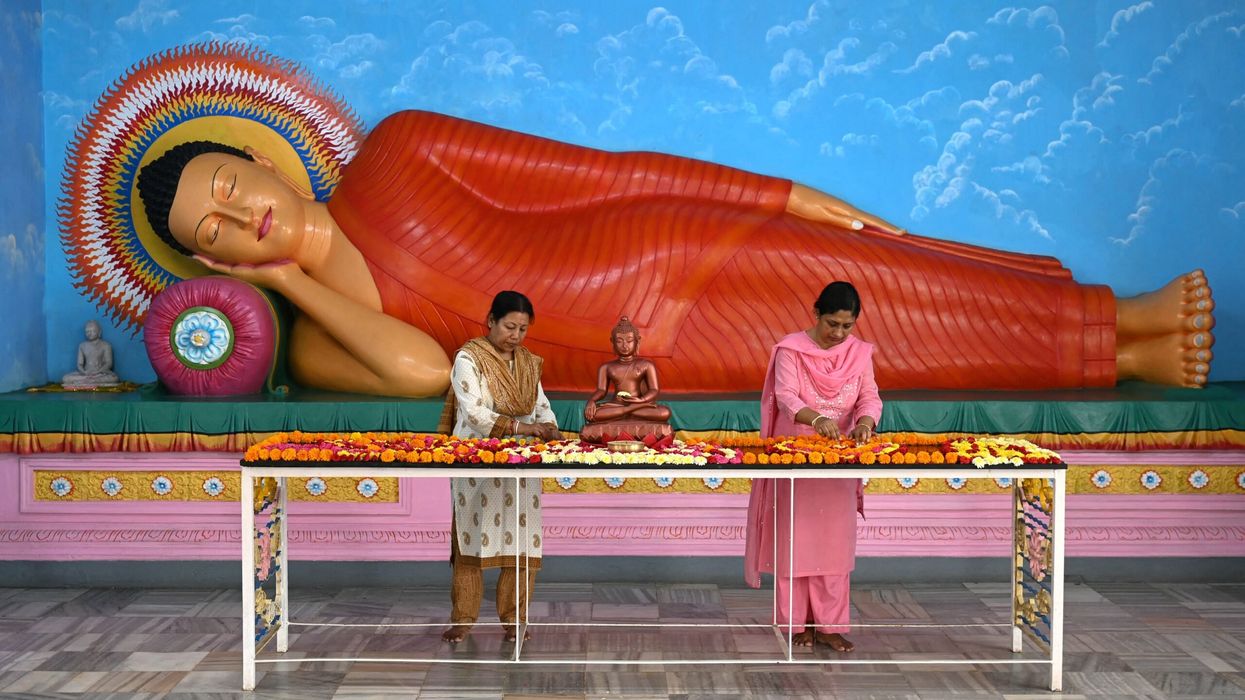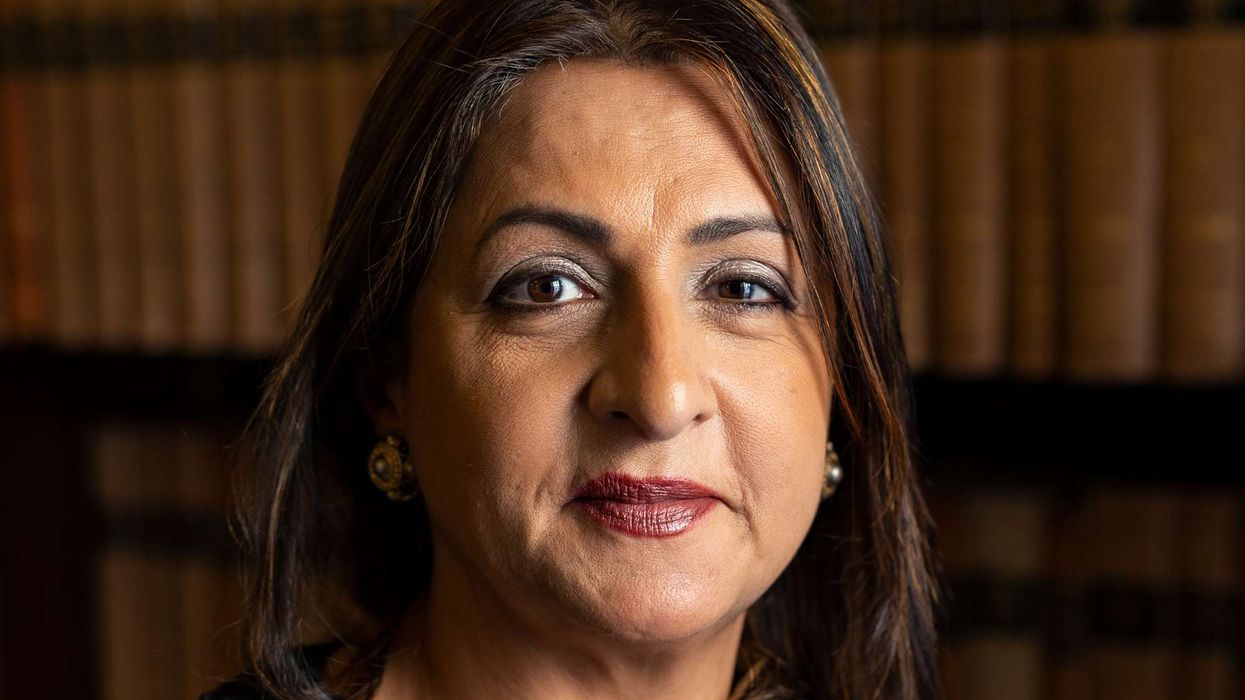WILLIAM DALRYMPLE has been on an extensive tour of the UK, talking about his new book, The Golden Road: How Ancient India Transformed The World.
In his introduction, The Indosphere, he has set out how India, not China, “was the beating heart of Asia between 250 BC and 1,300 AD”.
He begins: “‘People of distant places, with diverse customs,’ wrote a Chinese Buddhist monk in the early seventh century ce, ‘generally designate the land they most admire as India.’”
William DalrympleHe says: “Xuanzang was one of China’s greatest scholars, travellers and translators. When he wrote these words, he had just returned from an epic seventeenyear, 6,000-mile overland pilgrimage to the great Indian centres of learning. The account he wrote of that journey, The Great Tang Records on the Western Regions, makes it clear that the world he had just passed through, from Chang’an in western China to Kanchipuram in southern India, and back, was largely dominated by Indic ideas, art, science, languages and religions. In particular, he looked with profound reverence at India’s ancient Buddhist university monasteries, such as Nalanda, with their tens of thousands of learned monks. For Xuanzang they were simply the greatest centres of knowledge and scholarship in the world, the Indian equivalent of the great Library of Alexandria.”
The Chinese visitor was greatly impressed with Nalanda which the current Indian government has been trying to revive as a great university: “Lectures at Nalanda were given in a hundred different halls each day, he wrote, ‘and the students studied diligently without wasting a single moment’. He described the lecture halls, the stupa relic mound, five temples and 300 apartments and dormitories which housed the 10,000 monks and international scholars who gathered there. Between them they studied the texts of the different schools of Buddhism, as well as the sacred Vedas, logic, Sanskrit grammar, philosophy, medicine, metaphysics, divination, mathematics, astronomy, literature and magic. ‘The priests of Nalanda, to the number of several thousands, are men of the highest ability and talent,’ he wrote. ‘Their distinction is very great at the present time. The day is not sufficient for asking and answering profound questions. From morning until night they engage in discussions; the old and the young mutually help each other.’
“Above all, he described the glories of Nalanda’s library, which he regarded as the greatest repository of knowledge in the world. It was nine storeys high and contained three divisions: the Ratnadadhi, the ‘Sea of Jewels’, the Ratnasagara, the ‘Ocean of Jewels’, and the Ratnaranjaka, the ‘Jewel-Adorned’. Any manuscript could be borrowed, though Nalanda regulations held that it must be stored in the niche in the monks’ cells next to the square central courtyard. Here it was that Xuanzang studied for five industrious years, copying out by hand the Sanskrit manuscripts he wished to take back home to China. Later, these manuscripts would be translated, and recopied many more times, carried on to monasteries around China, Korea and Japan.”
A Bodhisattva carving in a Cambodian Hindu templeDalrymple says: “For most of late medieval and modern history, India was on the receiving end of a great deal of cultural influence from beyond its borders. Following the establishment of a series of Islamic sultanates throughout India in the twelfth and thirteenth centuries, Persian became the language of government across much of India, and Persianate cultural standards, in art, dress and etiquette, became dominant even in southern Hindu courts.
“Then, in the nineteenth century, during the rise of the East India Company and the Victorian Raj, English gradually replaced Persian, and India became instead part of the Anglosphere. To master English was now the route to advancement, and Indians who wished to get ahead had to abandon, or at least sublimate, much of their own culture, becoming instead English-speaking ‘Brown Sahibs’, or what VS Naipaul called ‘Mimic Men’. In time, of course, Indians became masters in both languages, adopting Persian and English as their own, and, just as Bedil Dehlavi became one of the most admired Persian poets in seventeenthcentury Central Asia, so many Indian writers from Tagore to Rushdie, as well as Naipaul himself, became literary superstars in English in the twentieth.
“But for a millennium and a half before then, from about 250 bce to 1200 CE, India was a confident exporter of its own diverse civilisation, creating around it an empire of ideas which developed into a tangible ‘Indosphere’ where its cultural influence was predominant.
“During this period, the rest of Asia was the willing and even eager recipient of a startlingly comprehensive mass transfer of Indian soft power, in religion, art, music, dance, textiles, technology, astronomy, mathematics, medicine, mythology, language and literature.”
He writes that “Sanskrit had been a profoundly sacred tongue for at least a millennium before the Common Era, but at some point between the first century BCE and the first century CE, Sanskrit was reinvented as a literary and political language, the start of an astonishing transformation of its use that saw Sanskrit literary culture rapidly spread all the way from Afghanistan to Java.”
Dalrymple made discoveries during his travels in Asia. For example, “to this day, the ancient capital of Thailand is named Ayutthaya after Ayodhya, Lord Rama’s capital in the great epic poem the Ramayana, while the national airline of Indonesia is Garuda, named after the god Vishnu’s mount. The spread of Sanskrit brought all of Indian literature, arts and the sciences in its wake.
“Out of India came not just pioneering merchants, astronomers and astrologers, scientists and mathematicians, doctors and sculptors, but also the holy men, monks and missionaries of several distinct strands of Indic religious thought and devotion – Vedic, Shaiva and Vaishnava Hinduism, or Sanatana Dharma as some prefer to call it, as well as Theravada, Mahayana and Tantric Buddhism.”
Dalrymple reflects: “Over half the world’s population today lives in areas where Indian ideas of religion and culture are, or once were, dominant, and where Indian gods ruled the imaginations and the aspirations of men and women. Meanwhile India’s intellectual influence travelled far to the west, giving us not only crucial mathematical concepts such as zero, but also the very form of the numbers we all use to this day. This is arguably the nearest thing the human race has to a universal language.
“Indian learning, Indian religious insights and Indian ideas are among the crucial foundations of our world. Like ancient Greece, ancient India came up with a set of profound answers to the big questions about what the world is, how it operates, why we are here and how we should live our lives. What Greece was first to Rome, then to the rest of the Mediterranean and European world, so at this period India was to South-east and Central Asia and even to China, radiating out and diffusing its philosophies, political ideas and architectural forms out over an entire region, not by conquest but instead by sheer cultural allure and sophistication. In matters of science, astronomy and mathematics, India was to be a teacher of the Arab world, and hence Mediterranean Europe too.”
He also states: “This entire spectrum of early Indian influence has always been there, hiding in plain sight: in the Buddhism of Sri Lanka, Tibet, China, Korea and Japan, in the place names of Burma and Thailand, in the murals and sculptures of the Ramayana and the Mahabharata in Laos and Cambodia, in the Hindu gods, rituals and temples of Bali. Yet somehow the Golden Road linking all these diverse forms and geographies into a single cultural unit, a vast Indosphere stretching all the way from the Red Sea to the Pacific, has never been recognised as the link connecting all these different places and ideas to each other; and up to now has never been given a name.”
He explains the importance of the monsoon winds: “Thanks to the winds of the Asian monsoon, India lies at the centre of a great network of navigable sea roads and maritime trade routes.
“Every summer, the heating of the Tibetan plateau creates an area of low pressure which sucks in moist, cool winds from the Bay of Bengal. Every winter, cold dry winds rake out from the snows of the Himalayas to the warm seas beyond. The Indian peninsula sits in the middle of this vortex of winds which blow one way for six months a year, then reverse themselves for the next six. The regularity and predictability of these winds generate monsoons that have allowed millennia of Indian sailors to raise their sails and propel themselves at speed across the oceans that surround them; then, when the winds reverse, safely back again.
“Early Indian traders used the sea roads of monsoon Asia to travel in two directions. Many headed westwards on the winter winds to the east coast of Africa and the rich kingdoms of Ethiopia. Here they had a choice. One northern fork led through the Persian Gulf to Iran and Mesopotamia; the other, to its south, via Aden, took them through the Red Sea to Egypt. Indian traders heading west used to arrive with the trade winds in early summer and ride the summer monsoon home in August; with the winds behind you, the journey from the mouth of the Red Sea to Gujarat could take as little as forty days, though if you missed the winds the round trip might take as long as a year, and cause you to take a prolonged holiday on the Nile. The equivalent overland route by camel caravan through Afghanistan would take at least three times as long”.
Sanctuary of Truth, a Hindu-Buddhist temple and museum in PattayaHe connects the past with the present: “In what is now Sri Lanka, Myanmar, Malaysia, Thailand, Laos, Vietnam and Cambodia, new urban centres were springing to life; and Indian traders were sailing there with every eastward monsoon, carrying cargoes of beads, textiles, metal goods and other Indian manufactures which they exchanged for spices, gold, camphor, resin and the other raw materials of the region. By the fifth century a major direct sea route had been established through the Straits of Malacca which easily linked the southern and eastern oceans, so taking Indian traders swiftly to China.”
He talks of gold: “The great Indian epics talk of Suvarnabhumi – the eastern coast of the Bay of Bengal – as an eastern El Dorado where fortunes were there for the picking. The Ramayana also mentions Suvarnadvipa, the ‘Islands of Gold’, and the seven kingdoms of the ‘gold and silver islands’ beyond Sri Lanka, the Indonesian archipelago, all with fabulous mines groaning with riches. ‘There,’ says the Monkey King Sugriva, ‘precious metals could be drawn from the earth as easily as mud elsewhere.’”
He writes of the genesis of Indian soft power: “Over the course of more than a thousand years, Indian religions, philosophies and sciences spread out in all directions across the Indosphere, like the shifting rays of a Sanskritic sun that sometimes penetrated surprisingly deeply into far distant recesses of the world around it. The book tells the story of the diffusion of transformative Indian ideas first around Asia, then around the wider world, focusing on three systems of Indian thought that emerged when it was the focal point of a sphere of influence that reached all the way from Afghanistan to Japan, with ripples lapping westwards to the distant shores of the Mediterranean.”
Dalrymple goes on: “The Golden Road first explores the birth of Buddhism in the fifth century bce as a usually non-violent and relatively egalitarian movement that rose as part of a great philosophical churning and transformation, partly in reaction, on one hand, to early Vedic Hinduism, with its strict caste hierarchies and its mass sacrifice of animals, and, on the other, to the harsh austerities of the ascetic Jains. It will follow Buddhism’s sudden leap to prominence under the Emperor Ashoka, who helped consolidate Buddhism as a pan-Indian religion and who sent missionaries around the world to spread the dharma – the path of duty and morality. It will then tell the history of the spread of Buddhism into Tibet and China, transforming culture, life and thought, a process which culminated in it becoming the court religion through the influence of the remarkable Wu Zetian, the first and only female Emperor of China. Today, despite all the trials of its recent history, China still has the largest numbers of practising Buddhists in the world.”
He adds: “The next chapters tell the story of how, at roughly the same time, the ruling elite of South-east Asia overwhelmingly converted to the worship of Hindu gods, while Buddhism became increasingly popular, first with the merchant class, then with the ordinary people, so much so that Theravada Buddhism remains the dominant religion today in much of the region.”
Dalrymple stresses that “perhaps it is in scientific rather than spiritual ideas that India stood out most dramatically. Only the ancient Hellenic world equalled it as a powerhouse of new concepts in mathematics and astronomy. By the time of the great fifth-century mathematician Aryabhata (476–550 ce), Indian astronomers had correctly proposed a spherical earth that rotated on its own axis, while using the decimal system and calculating the length of the solar year to an accuracy of seven decimal points. ‘I dived deep in the ocean of astronomical theories, true and false,’ wrote Aryabhata, ‘and rescued the precious sunken jewel of true knowledge by the means of the boat of my own intellect.’
Prambanan Temple, one of southeast Asia’s largest Hindu temples and a UNESCO world heritage site“The final chapters of the book will tell the story of how Indian mathematics, such as the number symbols we still use, the decimal system, algebra, trigonometry and the algorithm as well as astronomical discoveries, first passed from India to Abbasid Baghdad in the late eighth century. There the Abbasid viziers were a family of Sanskrit-literate hereditary Buddhist abbots from Afghanistan who had converted to Islam: the Barmakids.”
He concludes: “Finally, the extraordinary and little-known story of how Indian mathematics gave the world the numerals we all use today, tends to be studied in Arabic or possibly History of Science departments of universities, as it was through Abbasid Baghdad that Indian ideas of mathematics began their journey westwards. Yet to recount the diffusion of Indian influence during this period as three quite separate processes obscures a more extraordinary story still, and tends to diminish India’s role as a major civilisational centre.”
He writes of the concept of “Bharat” and returns to his Chinese visitor: “Zuanzang was not alone in having a clear understanding of the geographical boundaries of the fractured land he called India: his fifth-century ce predecessor, the Chinese monk Faxian, had similar ideas of a country ‘triangular in shape, broad in the north and narrow in the south’.54 Before that, the historian Strabo tells how Alexander the Great talked to sadhus who conceived of their homeland as stretching ‘from the mouth of the Indus in the west to the mouth of the Ganges in the east, from the mouth of the Ganges to the tip of southern India, and from there, again, to the mouth of the Indus’. The Mahabharata, which was in the process of composition at around the same time, gives an even more concise definition: ‘the land north of the seas and south of the Himalayas is called Bharata, where the descendants of King Bharata lived’.”
“This India, or Bharat, however defined,” writes Dalrymple, “was one of the two great intellectual and philosophical superpowers of ancient Asia, fully the equal to China in the broader ancient world. It set the template for the way much of the world would think and express itself, and would significantly alter the trajectory of the history of a great swathe of mankind. For more than a thousand years it was a garden that issued the seeds that, once planted elsewhere, flowered in new, rich and unexpected ways. Exactly how it did so is the subject of this book.”
The Golden Road: How Ancient India Transformed The World, by William Dalrymple is published by Bloomsbury. £30.












